In about a week you could be eating the best bacon of your entire life. You could be holding in your hand a glistening mahogany slab of perfectly crisped pink, tender, juicy meat streaked through with succulent fat. You could be proclaiming to the world: “Behold what I have made! It is bacon and it is sublime!”
Instead of some lame fruitcake, you could give people what they really want for the holidays: gourmet, handcrafted bacon, straight from your own kitchen. And here’s the secret I can now confidently reveal: making your own bacon at home isn’t just possible – it’s simple.
So, join me, if you will, in an exploration of how to make the best bacon of your life. There will be a few detours and footnotes to talk about some food sciencey-stuff, but if you want to get right to the meat (hah!) of the matter scroll down for the printable recipe.
Ready? Ok! Let’s make bacon!
What Is Bacon?
You know what bacon is, right? Or do you? In the United States, bacon is, by USDA definition, the cured belly of a pig. You rub a section of meat from the belly primal of a pig with a cure – salt, sugar, usually pink salt (more on that later) and seasonings of choice. After curing, bacon is smoked.
But all around the world people cure pork, and they don’t all stampede towards the fatty belly for a sweet-smokey meat kick. This post will teach you how to make American-style slab bacon from the belly of the pig.
Slab bacon is a delicious place to start, but check out this chart which shows some common bacons and bacon-like cured meats. Notice that pretty much every part of the pig can be made into something in the bacon family. Bacon doesn’t end with the belly!
What Do You Need To Make Bacon At Home?
Making bacon at home isn’t hard, it doesn’t require magical meat knowledge or a lot of fancy equipment. But it does require about a week’s time, a pork belly, one weird ingredient called Pink Salt, and a way to smoke your bacon. So while this project is totally, completely worth it, it helps to plan ahead.
1. Pork Belly
Getting a pork belly is not as straightforward or as cheap as you might think. I bought naturally raised happy-hippie pork belly through the wholesale vendor I’ve been working with since my catering days and it cost me $4.70 a pound. I bought three whole bellies, each between 10 and 12 pounds. That is a lot of bacon but I’m not a girl who backs down from a challenge.
If you buy your pork as a whole or half-animal directly from a farmer, ask the butcher to leave the belly whole. For the love of bacon, do not let them grind it!
Any good independent butcher will be able to order you pork belly (if they can’t they aren’t a good independent butcher) but depending on local demand may not have slabs of proto-bacon in stock. Asian and Latin-American markets tend to be a better source of pork belly that your typical suburban supermarket.
Previously frozen pork belly can be used to make bacon but your end product won’t be quite as moist.
2. Pink Salt
See full explanation below in the footnote. The TL;DR version is: pink salt is a special curing salt that ensures you don’t make Botulism Bacon. Order it online. This is what I use.
3. Smoker and Woodchips
For the smoker, I used a small “Little Chief” Electric Smoker given to me years ago by my sister and brother-in-law. (Guess what favorite cured meat they are getting for Christmas?) The smoker I have is a bitty thing – I have an older version of this model – and if you’re willing to invest a hundred bucks in a smoker I would recommend something more substantial. We are so overwhelmed by the awesomeness of homemade bacon that we are looking at upgrading to this smoker for Christmas.
But if this is your first time making bacon, you probably don’t want to invest in dedicated smoking equipment. You can rig a charcoal, Weber-style grill as a smoker. (See excellent instructions here, but note that for our bacon we want to keep the temperature at around 200-225 degrees.)
You can also build your own smoker out of, among other things, flower pots (clean ones, without flowers in them). Full instructions on building a flower pot smoker here. I’ve never done this, but it looks fairly legit.
You can also stovetop smoke your bacon. Check out this process for making a stovetop smoker at home with stuff you probably already have on hand. But – fair warning – indoor smoking will leave your entire house smelling like a campfire. For days. And unless you have some serious industrial ventilation in your kitchen, you might want to temporally silence any smoke alarms in the house. (Put those batteries back in, though!) Stovetop smoking works best to impart an initial smokey flavor and color, and you can finish cooking your bacon in a 225-degree oven. It’s not exactly the same, but it’ll do in a pinch.
For wood, I used bags of hardwood apple chips I picked up at the grocery store, like these. They aren’t too expensive. A $5 bag smoked two complete pork bellies, or about 20 pounds of bacon. You can use other types of smoking chips or chunks – alder, mesquite, etc. – depending on what your smoker set-up is, just make sure you are using fully dried hardwood chips designed for smoking. If you use any old woodchips from the muni tree grinding service you’ll get nastiness.
Making Bacon At Home: Step by Step
I’ve broken this down into lots of steps with lots of pictures, but don’t let that intimidate you. Each step is super easy.
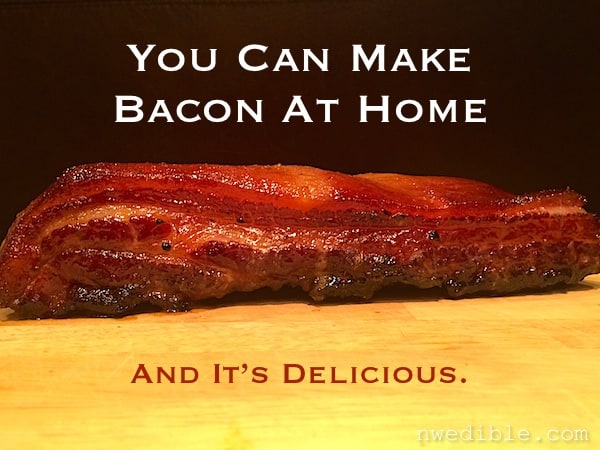
1. Get To Know Your Pork Belly
Here’s a pork belly, fat-side up.
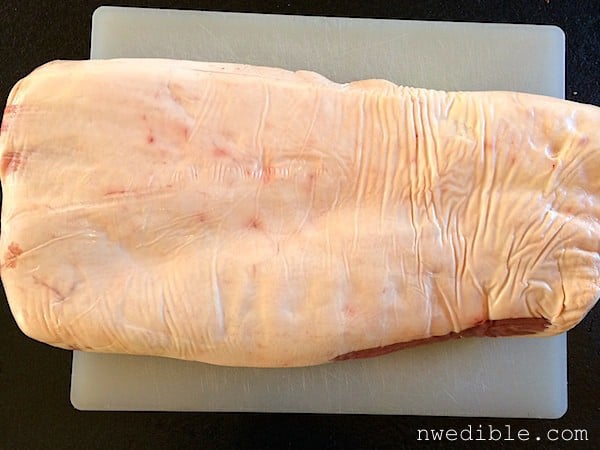
Here’s a pork belly, skin-side down. You can see where the full belly was cut off the ribs (those little fingery looking lines in the belly).
Here’s a pork belly in cross-section. Ah, now the bacony potential becomes apparent!
2. Trim Belly As Necessary
If you belly came with skin-on, carefully trim away the skin, leaving as much fat as possible. Mine came skin-off so I didn’t have to do this step.
Trim off any particularly thick membranes on the underside of the belly where the ribs connected. Smoke typically doesn’t permeate thick membranes like that, and they don’t break down with cooking, so they are like eating a rubber band. Below-right on this photo shows the belly before trimming; top-left shows it after trimming.
3. Cut Belly into Manageable Size Pieces
You could cure and smoke a whole belly, but you’ll need more specialty equipment. Cutting this 12-pound belly in thirds gave me pieces just the right size to fit into gallon-size ziptop bags. That’ll make life easier at cure time.
It’s important that your cure be properly calibrated to the amount of meat you are curing. The recipe in this post is designed for 4 pounds of pork belly (give or take a few ounces). If you cure a different amount, you must adjust the cure amounts accordingly.
4. Prepare Cure
Combine all cure ingredients in a bowl and mix well. Measure carefully and be particularly precise about the Pink Salt.
This is how the Pink Salt comes packaged.

5. Rub That Cure On Yer Meat
Really get in there and work the salt and sugar and spices into the belly. Give it a little massage and talk sweetly to it. This belly is going to be your bacon, after all.
6. Bag, Wait, Flip, Wait
Put your cure-rubbed pork belly in a large, heavy-duty ziptop bag. If any cure fell off the belly, throw it in the bag, too. Squeeze as much air out of the bag as you can without doing something gross with a straw, and seal it well.
Now, put your curing belly in the refrigerator. Soon, the salt and sugar will mingle with the juice from the pork and form a thick kind-of brine around the belly. Every day, more or less, turn the belly over so that all sides have equal time with the cure. This is why the ziptop bag is so great: you just flip the whole thing over without opening it. Give your pork belly seven to ten days to cure. After a week it should feel quite firm, but still pliable if you bend it. If it still feels soft, you can cure it for another day and check again.
7. Rinse Your Cured Pork Belly
After the pork belly is sufficiently cured, remove it from the bag and rinse it well. Some peppercorns may be stuck into the fat a bit and that’s ok, but do try to get most of the cure off the meat. This photo is from another batch of bacon I made with fresh garlic. Ignore the garlic hunks.
8. Check Pork Belly Flavor
When you are still getting the hang of how cured you want your bacon, it’s a good idea to do a taste-test before smoking. Although the bacon is cured at this point, it’s still raw, and, for a number of food safety reasons, I recommend cooking it before tasting. Just cut off a small sliver of the bacon and cook it gently.
If your reaction to the bacon is, “Wow, this tastes a lot like really good bacon!” then – excellent! – proceed to the next step. If your reaction is “Did I just eat a salt-lick?!” then your bacon may be slightly overcured. Remember you want something very flavorful, but if it’s excessively salty, you can fix it! Just soak your belly in cold water for a few hours and do the taste test again. The excess salt should be tamed.
9. Dry The Belly To Form A Pellicle
Here’s a fun fact about me: one of my favorite words is pellicle. A pellicle is the dry, tacky skin on meat or fish necessary for good smoking. Basically, moist meat doesn’t take smoke color or flavor very well, so before we smoke our bacon we have to dry it out.
The easiest way to do this is to put the bacon on a cooling rack over a sheet pan and pop in the refrigerator, uncovered, overnight. But I was impatient so I invoked a fan. It took about an hour to fully dry the meat with a fan assist like this, but don’t rush it. You want that nice, tacky-dry surface. I dried one batch on a cooling rack, and another right on the smoking rack that came with my Little Chief Smoker.

10. Smoke Your Bacon!
Okay, here’s where the magic happens. Prepare your smoker, grill, or whatever you are using to smoke your bacon. Get some nice hardwood smoke happening and then load your bacon. Keep the temperature in your smoker between 200 and 225 degrees as much as possible. Periodically check the chips and top up if necessary, but also pay attention to how much smoke color and aroma your bacon is developing. You may want to ease back on the smoke towards the end. I did.
11. Check – Is Your Bacon Done?
Bacon is done when the internal temperature is 150-degrees F (this bacon slab got there just after I snapped the pic below) and the bacon looks like lacquered love. In a good, efficient smoker this should take about two hours. In my smoker it took more like four hours.
Sidenote: Why 150-degrees?
At 150-degrees internal temperature, the bacon is glistening and lovely and the meat is fully cooked. However, very little of the fat has melted – most is still intact, so when you slice the bacon for later pan-frying, it looks like this:
I overshot on one of my bacon slabs and didn’t end up pulling it out of the smoker until it had an internal temperature of 180-degrees. That’s a big difference! The result was that the fat layers were starting to liquify and the meat was taking on a slow-braised quality, like this:
Now I don’t want you to get the wrong idea – this bottom example bacon was still unbelievably delicious. Even bad bacon, as they say, is pretty good, and this was still worlds better than anything store bought. However, this shows why 150-degrees is our bacon temperature sweet spot.
12. Eat Your Bacon
At this point, your bacon is fully cooked and you can, if you desire, start eating it. However, if you are a typical American bacon eater, you will probably want to pan-fry or oven roast a few slices to crispy, chewy perfection.
Slice as you desire – as thin as I could confidently slice made hunking thick-cut bacon slices of magnitude. Cook this bacon gently – give it time over medium or medium-low heat and it will reward you.
No joke: best bacon I’ve ever eaten. Seriously, what are you waiting for?
Printable Recipe For The Best Bacon Ever
You Can Make Bacon At Home!
Recipe adapted from America’s Test Kitchen DIY Cookbook. I cut a 12-pound pork belly in thirds so I could trial three different cures. This gave me three pieces of pork belly, each about 4 pounds. All the cures were fantastic, but we most enjoyed the Traditional cure. Start with the cure from Basic Bacon and explore and play around. Find your own favorite homemade bacon flavor!
Ingredients
Bacon #1: Basic Bacon
- 4 pound pork belly
- 1 cup brown sugar
- 1/2 cup kosher salt
- 3/4 tsp pink salt
- 1 tbsp cracked black peppercorn
Bacon #2: Traditional Bacon
- 4 pound pork belly
- 1 cup brown sugar
- 1/2 cup kosher salt
- 3/4 tsp pink salt
- 1 tbsp cracked black peppercorn
- 2 fresh bay leaves, sliced
- 1 tablespoon minced fresh thyme
Bacon #3: Spiced Bacon
- 4 pound pork belly
- 1 cup brown sugar
- 1/2 cup kosher salt
- 3/4 tsp pink salt
- 1 tbsp cracked black peppercorn
- 1 tbsp Garam Masala
Instructions
- Prepare pork belly by removing any skin or tough connective tissue and, if necessary, cut belly into 4-pound slabs.
- Combine cure ingredients and rub cure on belly, working cure into meat. Transfer belly and any extra cure into to a gallon-size ziptop bag.
- Refrigerate belly for seven to ten days, flipping belly once a day, until meat is fully cured and firm but still pliable.
- Rinse cure off belly, and dry well. Allow meat to form a pellicle by drying overnight in the refrigerator uncovered or setting meat on a rack in front of a fan.
- Prepare smoker. Smoke belly over hardwood smoking chips at 200-225 degrees for about 2 hours, until internal temperature of pork reaches 150-degrees F.
- Wrap bacon well and refrigerate for several weeks, or freeze for up to three months.
- To serve, slice thinly and pan-fry over medium or oven-roast slowly.
Footnote: Pink Salt, Prague Powder, Nitrites, Etc.
Pink Salt, also called Prague Powder, InstaCure or DQ Salt is a curing salt. You don’t use it for flavoring or seasoning – you use it to preserve meat and a little goes a long way.
It’s called Pink Salt because it is dyed pink so no one mistakes it for table salt. It is not the same as Himalayan pink salt! I saw a website telling people they needed to use Himalayan Pink Salt to cure their meats and I almost choked on my slab of pate. Not the same thing! So, to emphasize: Himalayan salt – or any other fancy boutique finishing salt of any color at all – is not what you need here.
There are two standard formulations of curing salt.
Prague Powder #1 (also called InstaCure #1) contains table salt and 6.25% sodium nitrite and is used for sausages, cured meats, pates, deli meats, etc that are cooked – smoked, baked, roasted, canned, whatever. Basically any cured meat that isn’t long-aged like a dry-cured salami. This is what we use when we make bacon. You can get it here.
Prague Powder #2 (also called InstaCure #2) is used for long aged dry-cured meats like prosciutto and hard salami. It has table salt, sodium nitrite (6.25%) and sodium nitrate (1%). The nitrate acts as a kind of slow-release preservative for very long-cured meats. We don’t use it to make bacon or other short-cured items.
Nitrites? Are You Ni-Trying To Kill Me?!
“Wait!” I hear some of you saying, “Nitrites! Oh my God, evil toxic additives.” Hold on a second – before you slam your laptop lid in disgust, let me break down my position on Pink Salt for you.
Remember our old frienemy Mr. Botulism Toxin? (See: How Not To Die of Botulism) Did you know that botulism was first described “as a ‘sausage poison’ and ‘fatty poison’, because the bacterium that produces the toxin often caused poisoning by growing in improperly handled or prepared meat products.” (Wikipedia, emphasis mine.) Even botulism’s name comes from a cured meat product: botulus is Latin for sausage.
Sodium nitrite in the form of pink salt, when used according to established standards, prevents the growth of C. Botulinum and the development of the botulism toxin in cured meats. That’s why it’s in there. As an added bonus, the nitrite enhances color, flavor, and texture in the cured meat.
Okay, so on one hand we have this established risk of botulism growth in improperly cured meat products. On the other hand we might have the potential risk of nitrites. So we have to ask ourselves, what is the risk from nitrites when used according to established guidelines? I believe the answer is – little to none, but of course this is something you should investigate if it concerns you. For more info, I recommend The “No Nitrites Added” Hoax by Micheal Ruhlman. I am, personally, firmly in the pro-Pink Salt category.
Related Stuff…
(These are affiliate links. Purchases made through these links cost you nothing extra but allow me to bring you more giant step-by-step cured meat tutorials. Full financial disclosure here. Thanks for your support, guys, I love ya more than a homemade BLT in late August.)
America’s Test Kitchen DIY Cookbook. This book is fabulous. If you are the kind of person who reads all the way to the end of a three-thousand word primer on homemade bacon, you should go buy this book right now. It has all kinds of fun DIY Kitchen projects, from bacon to crackers, granola to jam, cheese to pate. And every recipe I’ve made from here (eight at last count) has turned out spectacularly well.
Charcuterie: The Craft of Salting, Smoking, and Curing and Salumi: The Craft of Italian Dry Curing, both by Michael Ruhlman. If you want to go deeper into cured meats, you would be hard pressed to find a more enthusiatic guide than Ruhlman in these two books. Also check out his excellent personal website.
Pink Salt. Remember, you want Prague #1 for bacon and everything that isn’t long-dried. This link goes to the same pink salt I use.
Wood Chips. I like Applewood because they are mild and have a fruity note that complements pork wonderfully. But play around – there are lots of different kinds of smoking wood.
Dedicated Smoker. If you have the room and the funds, there are a lot of options out there. I am leaning to upgrading to this Masterbuilt Electric Smoker because it gets excellent reviews, is electric (easier for me than propane) and hits a good value-conscious price point. I definitely recommend looking for adjustable temperature controls and an auto-shut off timer. Those are two features I really would have liked.
81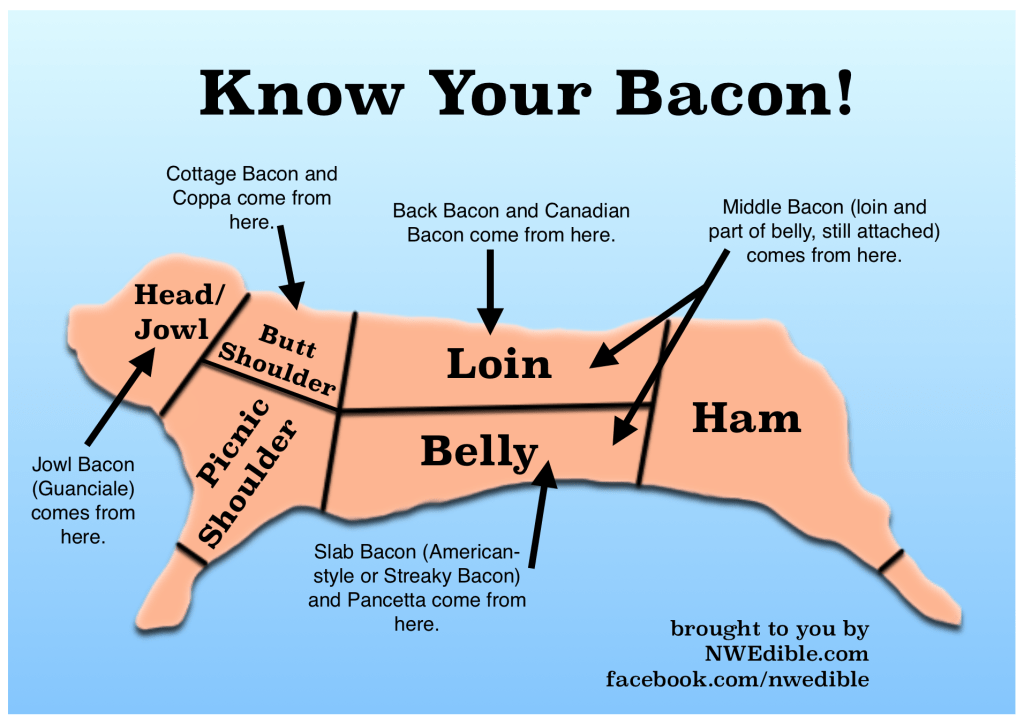

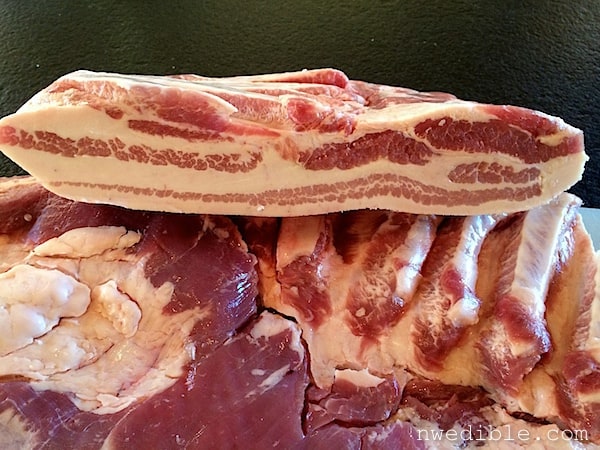











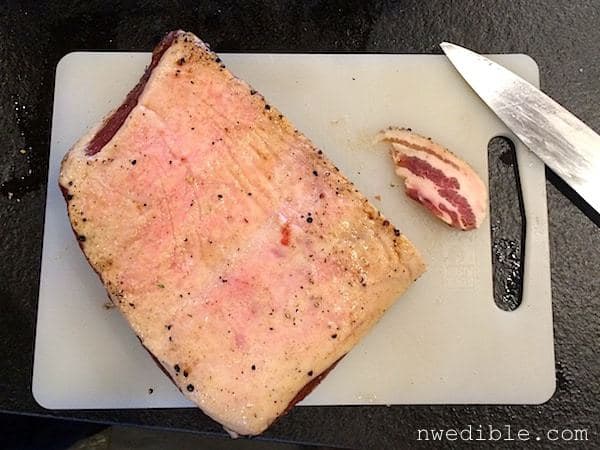
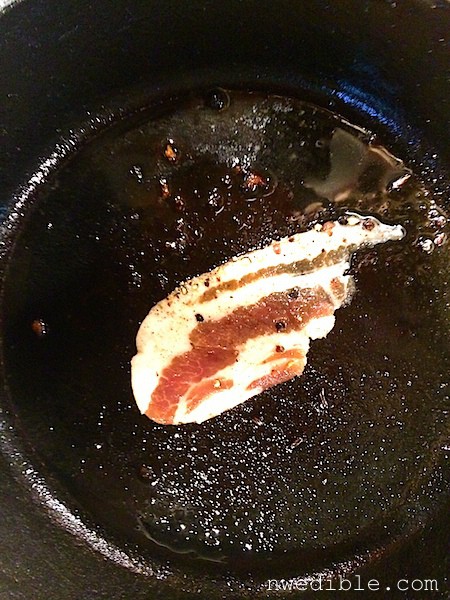
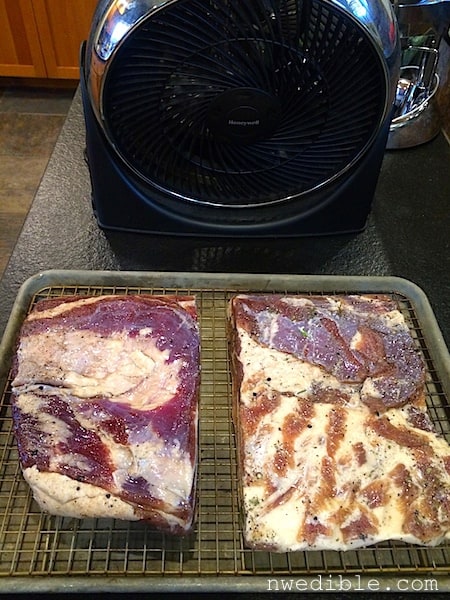
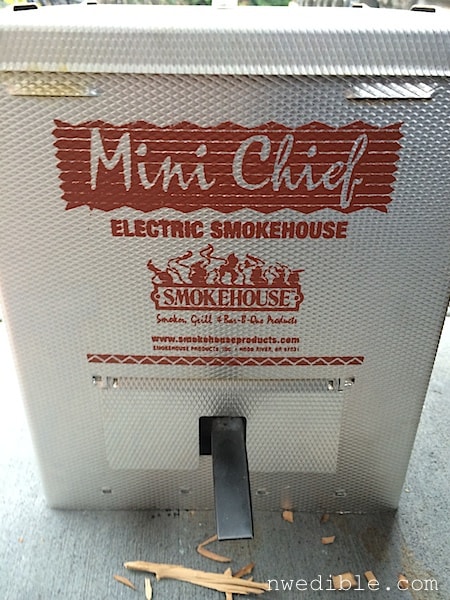
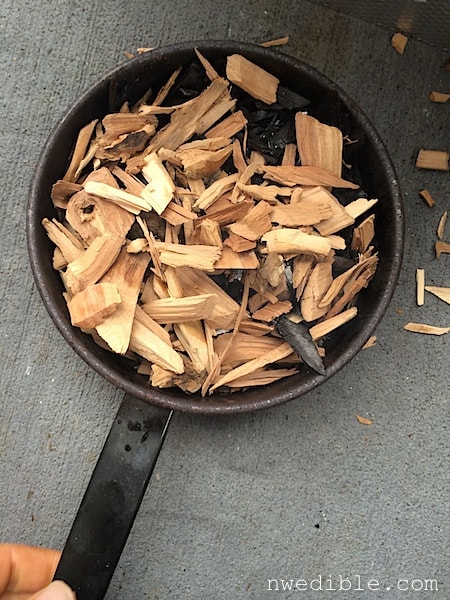
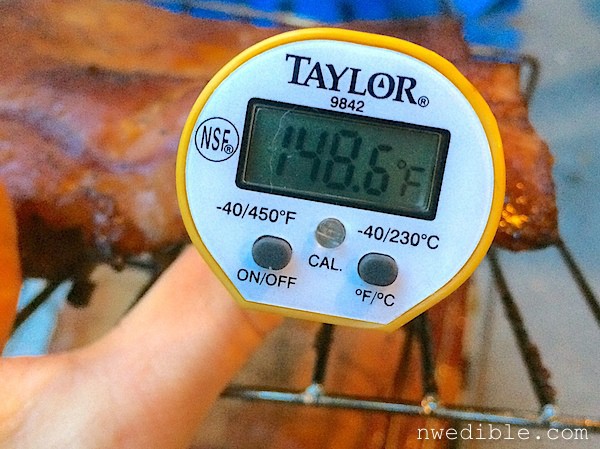
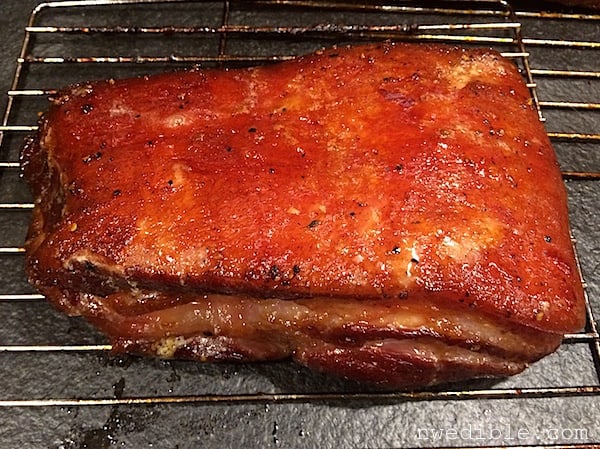
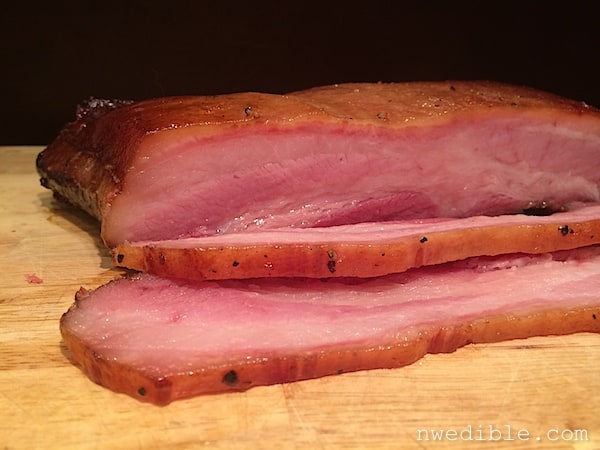
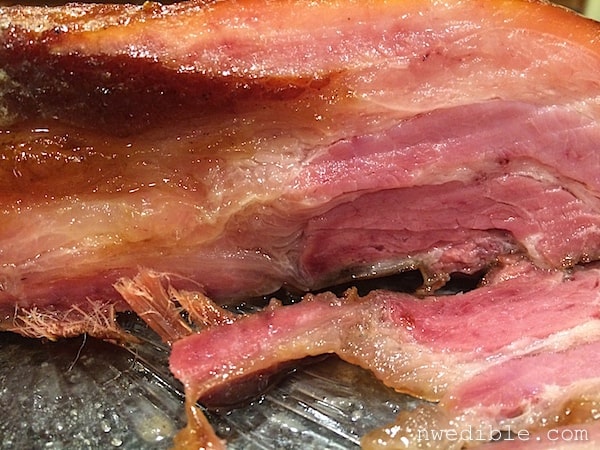

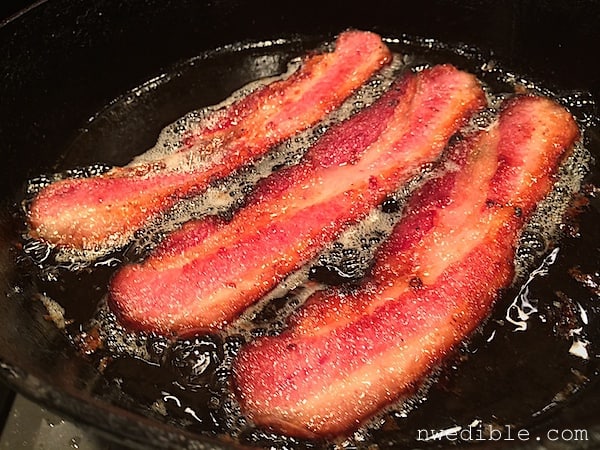
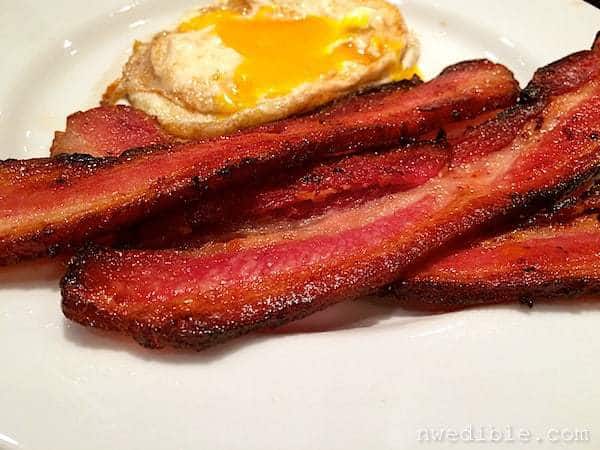
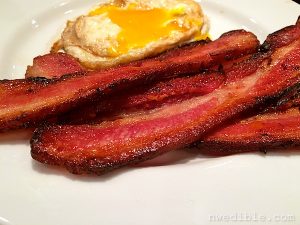
HELL YES. This really makes me wish I weren’t the only meat-eater in the house. On the other hand, all that beautiful freshly-made bacon could be just for me… 🙂
No one else would snatch a piece from you!
I read this article twice. Slowly. Mmmm
ROFL!
At least you were *reading*! I was just looking at the photos and drooling…
Nicely done!!! I can’t wait to try it out on my Traeger smoker. Hubby and I have been talking about our own bacon for some time.
You will NOT regret it!
How long does the smoked bacon keep, and how should it be stored?
Wrap bacon well in plastic wrap and refrigerate for several weeks to a month, or freeze for up to three months in a heavy duty freezer bag. Probably more like 6-12 months in the freezer if you vacuum seal it.
While I love apple-wood smoked bacon, is it possible to try this without that step? The bane of a small apartment with an even smaller kitchen, and no outdoor smoker to speak of…
That said, holy god does that look good.
You can. From a food safety perspective and stuff you’ll be fine. What I would do in your situation is bake the bacon to 150-degrees in a 225-degree oven. You won’t have the full smoky flavor and color, but it will still taste very good. You might experiment with adding a tsp or so liquid smoke to the cure, too.
Oh perfect–a local spice shop actually sells smoked peppercorns, so I might try it with those for some smoky flavor as well.
haven’t tried so I don’t know if it would work or not, but maybe it would be possible to put some wood chips in a pan on a lower rack in your oven.. would probably be as smokey as stove top, but idk?
I must say, I thoroughly enjoyed this article and really want a smoker now…
Our town has a specialty spice shop with smoked salt, too, including applewood flavor. Good luck!
I never thought I could make my own bacon until now. Thank you for showing the step-by-step process. I am book marking this for later.
You can totally do it! It’s actually pretty simple.
I have died and gone to heaven. We are forever grateful to your write-up.
If you don’t have access to a smoker, I’d recommend making guanciale instead, which is usually unsmoked. It’s more flavourful than belly bacon, and a required ingredient for making spaghetti carbonara (as well as sugo all’amatriciana). Any butcher worth her salt should be able to sell you a pork jowl. Well, now I’m hungry too!
I have thought about making bacon at home for quite awhile, but I think you have now motivated me to get off the dime and do it.
By the way, I have had the Masterbuilt electric smoker for several years now and cannot say enough good things about it. Very well, built and easy to use.
we are slaughtering a couple of hogs in 3 weeks and have been looking all over for good recipes and instructions for bacon, hams, etc. Thanks for the post!
Oh.. My.. Goodness.
Such an amazing tutorial and the pictures make me wish we were having breakfast for dinner.
So glad you mentioned the America’s Test Kitchen DIY Cookbook. My friend & I just did the duck breast prosciutto from the book. The first taste was amazing. I am restraining myself from telling her that the cat got it all & hoarding it for myself (she raised the duck; I had the spare fridge room for it to hang to cure). Your bacon looks amazing!
Now you’ve done it Erica! I have an uncontrollable desire for BACON!
On the subject of smokers, my husband smokes a lot of salmon in his Little Chief smoker. In order to cut down on smoking time and keep the temperature at a steady rate he has built a high grade styrofoam box to slide over the smoker. It covers all but the opening that you use to change the pan of wood chips. I am not sure where he got the styrofoam – it is similar to what he had in the fish hold of his commercial troller years ago, so perhaps a marine supply store? Just make it big enough to slide over the smoker with enough room to where it doesn’t touch the smoker. He used to have a cover he had made out of strips of insulation – the new one works much better!
I was watching Alaska the Last Frontier (the only “reality TV” I watch as I think it is somewhat educational for someone like me that wants to get back to the country and be more self-sufficient)
last weekend and they built a smoke house. I wonder what city laws (I live in Everett, WA) are regarding something like that?
Yes! Great tip – the insulation really helps with the thin, metal, less expensive type smokers. On my second batch I surrounded the smoker with a heavy blanket, like the kind moving companies use to pad furniture, and that made a huge difference! The temperature got a lot higher – that’s actually why I ended up overcooking a batch. It went a lot faster with the added insulation.
Thank you so much! I love your blog and this is a terrific idea for a unique handmade gift for the holidays.
Oh boy, I’ve been oogling smokers, and now I’m officially in the “I want it!” category. I love bacon, I mean really, really love bacon. I was (now, confused) in the minimum-nitrite category of people. But then again, botulism sucks and the attached article was compelling. I usually say that it’s difficult for me to be misled – what just happened?!? Was I on the no-nitrite train just for funsies?! Lucky for me I’m a chemist and have access to all those fancy research journals, so I’m going to do some reading tomorrow… thanks for the push in the right direction. I love learning new things! And bacon, I’m with you there.
Yeah, I thought the same about the nitrites… but botulism sucks.. so I will make myself feel better about it knowing that I know all the other ingredients and they are high quality.. but I still wonder if sea salt would work as good in higher doses?
Since you are a chemist, I am VERY interested in your scientific conclusions. Please let me know what your read of the actual research says. What I’ve read is that, at very high temperatures, nitrites can convert to carcinogenic compounds. But that’s true of meat in general. Burn it and it’s not good for you. I also know that “nitrite free” cured meats are, in fact, full of nitrites from celery juice and extracts, which is chalk full of “natural” nitrites. My impression is that the nitrite content of celery is variable, and so often more is used than is necessary to insure good cures. Again, would love to know what those real science journals are saying! 🙂
Thank you for demistifying nitrates for every one. Things every one seems to be afraid of fat, nitrates, salt, real sugar, real butter etc. If we do everything in moderation(including moderation) we would all be better off.
I have the better part of half a commercial hog in my freezer…including the belly. I will certainly be using this recipe and procedure for THAT! And probably for an improbably monstrous ham from the same animal, which I’m pretty sure I’m going to have to bone out and do in pieces. There are a couple of salmon waiting for the next time I fire up the smoker, too!
My smoker is a handy little offset Char-Broil, and I don’t use it often enough—though I did just smoke an eleven pound turkey in it today. I ran some apples through my juicer, mixed the fresh juice with a little Redmond salt, injected the bejasus out of the bird with that; brined it in a salt and honey brine for about 24 hours and smoked it with apple wood from the tree in my yard. DIVINE.
So here’s a question; seems like we get an awful lot of air quality burn bans in Pierce County, and there is no good way to predict one a week or more out….except to expect it on a Friday. >:-( What if on day seven of the cure, they call a burn ban? Load up the smoker and bring it your house? LOL!
Eeek! That smoker you want is 46% off right now–do you know this? What a deal! We are weber smokey mountain folks, but that’s a steal at less than $200.
Bought it! 🙂
Oh wow, looks amazing. I was trying not to drool over my computer 🙂
For clarification, the temperatures you talk about are in Fahrenheit? We use Celsius over here.
I’m going to persuade my parents to let me borrow their kitchen to make this
All Fahrenheit. Sorry we have a stupid system of measurement here. 😉
Lord Have Mercy.
We are back to living in an apartment, so I can’t smoke it, but I look forward to trying the baking method over Christmas break. Thank you!
I don’t remember how I came across your blog but I have to say, I love it! I live in a small flat in London so no possibility of smoking but you’re certainly an inspiration with these posts and you’re a great writer!
Excellent tutorial. Big thanks for not suggesting folks “soak the wood chips” prior to smoking. “Wet steams and Dry smokes!”
I am frequently the beneficiary of “food tests” when Erica sets out on some new adventure for her blog, (the pork with pistachio and the chicken liver pate’ were both fantastically good) but so far I haven’t had any of this bacon. Erica, this is a Christmas hint!
Can I borrow your new smoker for the sausages I made this weekend?
DAD
Masterbuilt makes a well designed cold smoking accessory. I am looking at piping one up to my grill to smoke cheese and fish. I hope to acquire the hot smoker unit later. I can hot smoke foods that finish within an hour in my grill, but temperature control is touchy.
This might just be the best DIY ever. No joke. With a new charcuterie opening up soon (featuring all local meats), this is going to be a divine undertaking!
I might just have to give in on Dad’s desire for a big green egg to smoke homemade bacon… And the ATK DIY book is *awesome* – their cheese cracker recipe beats the pants off the store bought ones.
Erica, thank you for posting this recipe. My wife and I love your blog and we can’t wait to try this recipe.
I made bacon for the first time about a month ago. We purchased a whole pig (what was I thinking?!) and I had the butcher leave the belly whole and uncured. I am pretty happy with the result, although I feel like it’s a bit over-smoked. To be fair, I like bacon, but I’m not fanatical about it. My husband, who’s a bigger bacon fan than I, is very pleased with the result.
I did set aside 5 lbs of the belly and made pancetta and Oh.My.God. That stuff is freaking amazing. I doubt I will be sharing that.
Yet another rabbit hole of DIY-hippie-homesteading. Now I want a smoker. And I obviously *need* a humidity controlled “cave” of some sort for curing meats and aging cheese (I’m in southern CA – we are neither humid nor consistently cool enough to create a natural spot for either condition, much less both). Further proof that simple living =/= a minimalist ethos. Damn it!
I use part of my wine chiller for curing meat. I have guanciale hanging from one of the racks as we speak.
pork belly is sold EVERYWHERE here… unfortunately, pink salt is not. I wonder if the company you linked to ships to Europe? Sigh… homecured bacon… drool…
I will never take good bacon for granted ever again. 🙂 You are Wonder Woman for taking on the process! Too bad you don’t live close or I would try to trade you bacon for homemade tamales.
This looks fantastic. I know what I want for Christmas now: a smoker.
Thank you, thank you. 🙂
I dont understand why you are hot smoking the bacon instead of cold smoking it and then cooking it as needed. I use a Smoking Gun cold smoker for my bacon, infusing it 3 times, and then slice and freeze. i keep the skin on until i slice the bacon. i think it is easier to remove once the bacon has been cured, so i wonder why you do that ahead of curing. Does it help cure faster? Re nitrates, worth pointing out for your audience that it is not really necessary to use pink salt on a cured meat that will be cooked at a temperature that would kill botulism anyway, but it does keep the meat pink.
Many ways to walk the cured meat path! Glad you have one that works for you. One point of clarification – the botulism toxin isn’t denatured at 150 degrees F. It begins to denature at 176 degrees F.
Good to know. If you are frying bacon in a pan to crisp status, i would think you would pass 176 F. .???
“botulism toxin isn’t denatured at 150 degrees F.”
And for that reason I would hesitate to refer to bacon brought to an internal temperature of 150 degrees right out of the smoker as “fully cooked” (step 12 above). Tempting as it looks and smells, it still needs frying before it’s consumed!
But otherwise great post. I’ve been curing & smoking my own for quite a while, using cherry wood and a Big Green Egg for the smoke. I leave the skin on during smoking, then trim it (the skin makes wonderfully smoky, gelatinous pork stock), freeze it, slice it with a deli slicer, and vacuum seal it for freezer storage. Nothin’ finer.
Okay, now I’m sitting here drooling over bacon and adding a smoker to my list of things I *need*. Not want, *need*. Any chance you’ll do a similar tutorial on homemade salami? Pretty please?
I’ve been thinking about making bacon for a while now. Your wonderful tutorial has given be me the inspiration to get to it. I’ve read it four or five times and I am getting started. But unfortunately, I am a little slow and just getting my cure started tonight. I plan to smoke next Sunday, and can’t really push it back. You say 7 to 10 days, but what if I don’t have that much time (I guess I have just 5 or 6 days)? Can I compensate for the short time with more cure or something else?
Caution: Bacon can lead to Salami and other cured meats!
https://www.facebook.com/photo.php?fbid=593015170771133&set=a.112321208840534.16311.100001879653471&type=1&theater
Did it! Followed your traditional recipe, smoked it in the Weber. Overall worked out great. At 8 days it didn’t seem salted enough, then I ignored it for two days and it was too salty. Didn’t notice the salt load until after I smoked it though. So I sliced it and let it all sit in water for 30 minutes. I figure it’ll mellow the oval smokiness and perhaps the sweetness too, which is cool because I thought it sweeter than my preference and our daughter thought it too smokey. I’ll fry and retry the taste test tomorrow. In the SF area, so the meat was $8/lb. a great experiment. Worth the effort and fun.
I’m smoking beef bacon today – using your blog post as a guide. 🙂 Thanks for being an inspiration!
We are going to raise two pigs this year for October butchering and one of my concerns was about the bacon I could get. Thanks for this great article. Perfect timing.
I just got a Masterbuilt electric smoker, primarily to smoke my bacon.
This smoker has a lot of good features but I like the fact it’s insulated which helps control/hold temps. Temps; keep your digital probe handy, my smoker seems to read 20-30 degrees high.
Other than that it’s a nice piece of equipment.
I don’t know how I’ve lived here in the PNW for more than ten years and just found this blog! OMG! I’m so excited to find others who speak my language of canning, gardening, cooking – and most importantly, eating!
I had to add a Charcuterie notebook to my Evernote recipe collection, just for this post.
Next time I’m at my butcher shop I’ll have to ask about ordering pork belly.
There is a semi-local butcher (30 minute drive, but near our favorite state park) that makes the most amazing bacon for around $5/lb. It’s so good that I even enjoy leftover cooked bacon cold, out of the fridge.
But knowing how to do it yourself is even cooler. I adored the charcuterie part of “Farm City”.
Also, how have I never heard of ATK’s DIY cookbook?
Thank you! I was ready to call the butcher to ask him to please send the bacon out to be smoked, that I’d chickened out. I really want to do this myself and now, after reading your instructions (and a lot of drooling over the photos of frying bacon), I’m going to stick with my plan. I can do this!
I made my first batch of bacon last month and have been enjoying it ever since. I did a maple/ cracked pepper cure… Heaven.
If you are looking for a neat trick for thinner bacon slicing a vegetable mandolin works GREAT. I have an adjustable mandolin that I use for shredding cabbage for sauerkraut, and it is more than sharp enough to handle a slab of bacon. I can adjust from “grocery store thin” to a big ol thick slab, and get consistent slices every time.
Beautifully Done, Technical yet funny and curious.. Congrats for your way to teach people and make it fearless, easy and mod of all FUN!! What actually, cooking should be ALL ABOUT!
BOB
fabulous info thank you for sharing! I’ve been tinkering with smoking meat here and there but never taken the step to dealing with meat that requires curing salt, ie Prague powder #1 yet. Here is a question for anyone… from my research it seemed like that in Europe the mixture – the ratio of table salt to nitrite is a tenth of what is used in the usa? Ie 0.6% vs 6% (the remainder by weight being table salt). Ie, ten times more nitrite in the “Prague#1 salt mixture” in the USA. (Forgive me if I’m wrong on this, misunderstood .)